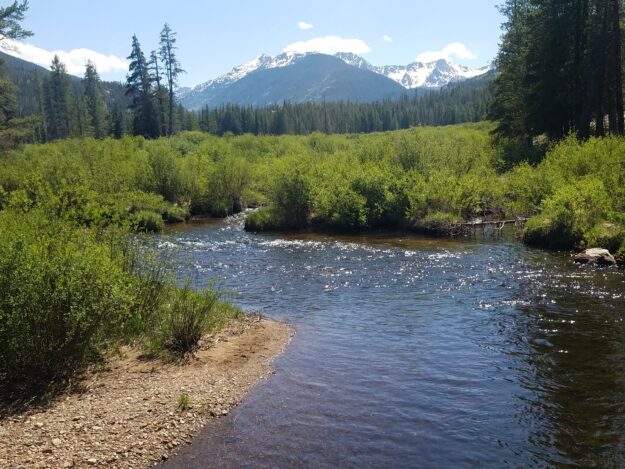Widgetized Section
Go to Admin » Appearance » Widgets » and move Gabfire Widget: Social into that MastheadOverlay zone
Opinion: Time for Coloradans to tear up turf as climate change dries up our rivers

In 2002, a drought hit Colorado. Conditions were severe, and water managers in several Front Range cities imposed mandatory restrictions on outdoor water use.
The restrictions worked. Denver Water, which serves about a quarter of the Colorado population, achieved a decrease in per capita water use of more than 15%. Lafayette saw a 55% decrease.
The measures seemed extraordinary at the time. Now they’re routine.
In the last 20 years, Colorado and the Southwest have experienced the most intense drought since at least the late 1500s. It’s so hot and dry that it no longer makes sense to call it a drought — “megadrought” has become the preferred term for what’s happening in the region, which is said by scientists to be undergoing “aridification.” Human-caused climate change is largely to blame.
The warming trend has applied increasing pressure to water systems. The Colorado River, which starts north of Grand Lake and supplies water to 40 million people, “is tapped out,” as NPR put it this month. A study published last year estimated the river could lose up to 31% of its historical flow by 2050. That’s just the starkest example of ailing waterways. Other watersheds in Colorado are in similar trouble.
Since 2002, Denver Water has imposed water shortage rules basically on a permanent basis. Customers are allowed to water lawns only during certain times of the day and no more than three days a week.
But climate change and strains on the state’s water supply will continue to worsen, even as the Colorado population grows and creates greater water demand. That’s why Coloradans must further rethink water use and find better ways to conserve this vital resource. They should achieve greater efficiencies and, as with the irrigation of turf, eliminate wasteful uses. This is a responsibility to be borne both by individuals and government leaders.
Coloradans in fact have done a comparatively good job of conserving water in recent years. In the Denver Water service area, including Denver and suburbs, customers from January to May notched a 50-year water-use low, even with an addition of 600,000 people in the growing metro area. This aligns with other efficiency trends in the Southwest. Colorado River’s population-dense Lower Basin states including California have posted substantial use reductions.
But such advances are only steps in the right direction, not the destination, because the forces that prompted them are increasing.
Nevada last month enacted a law that essentially bans grass — “nonfunctional turf” — throughout the Las Vegas area. The move should serve as a model for Denver.
If that sounds extreme, the city is headed there already. The Denver Green Code, part of the city’s building code, is a voluntary pilot program that includes water use efficiency standards, including a call for 60% of landscaping to include only qualified trees, drought-tolerant ground cover, low-water shrubs and xeric grasses. Such standards should become permanent and mandatory.
Individual Coloradans don’t have to wait a day to do their part. Anyone in the state who owns property with excessive expanses of thirsty grass can at this very moment acknowledge how unjustifiable it is to maintain and begin a transition to more appropriate vegetation. Denver is not the desert that Las Vegas is, and some turf has its place in Colorado. But gratuitous grass has got to go. There are many resources to guide a transition to region-friendly plant alternatives, such as Plant Select, the Colorado Native Plant Society and the Denver Office of the City Forester, which publishes a list of approved street trees. Coloradans should plant more region-friendly trees, because they provide cool shade in the heat, absorb carbon dioxide and beautify the neighborhood. And special attention should be made to getting more trees into low-income neighborhoods, which have traditionally enjoyed less tree cover than affluent areas.
Turf is an easy target. Single-family homes account for almost half of Denver Water’s retail customers, and half of the water those homes consume goes to outdoor use. But substantial water efficiencies can be pursued inside, too, with water-efficient appliances and repairs to leaky fixtures.
The Legislature has a role as well. State lawmakers in 2014 enacted water efficiency standards on plumbing fixtures sold in Colorado, and in 2019 they passed a law that in part required new spray sprinkler bodies sold in the state to have a pressure regulator and meet efficiency standards. Each violation could come with a fine of up to $10,000.
There is more that lawmakers can do. For example, they can follow the lead of states like California and adopt minimum statewide standards for efficient landscape irrigation, gray water use, stormwater capture and turf reductions.
Such measures don’t account for agriculture, which represents the vast majority — 86% — of water use in Colorado. The efficiency calculation for farms and ranches is entirely different and more complex than for homes, businesses and municipalities.
But, at a time when water is increasingly scarce, heat waves are battering the state, and the brutalizing grip of climate change is growing, every person should do everything possible to conserve every drop. SUPPORT NEWS YOU TRUST. DONATE
Editor’s note: This opinion column first appeared on Colorado Newsline, which is part of States Newsroom, a network of news bureaus supported by grants and a coalition of donors as a 501c(3) public charity. Colorado Newsline maintains editorial independence. Contact Editor Quentin Young for questions: info@coloradonewsline.com. Follow Colorado Newsline on Facebook and Twitter.


